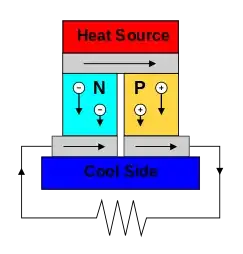I've been reading Tanenbaum's Structured Computer Organization and he says one of the major bottlenecks for increasing CPU clock speed is heat. So I started thinking: Is it possible to remove the heatsink altogether and use that heat to generate more electricity? I've been searching on this and found these thermoelectric materials and this thermoelectric generator:
I read on that Wikipedia article that "Silicon-germanium alloys are currently the best thermoelectric materials around 1000 °C (...)", and I know CPU normally operate around 30~40°C. So, getting to 1000 °C would require more CPUs.
So I thought: What about putting a lot of CPUs in parallel without their heatsinks to gather more heat? We can also overclock these CPUs a whole lot and see how much heat they can generate.
But I'm stuck. I don't know what to think next. I don't even know if it's a good line of thought.
My question is: why not develop some sort of heatsink that generates electricity from the CPU's heat? I know somebody must already have thought about that and thought about a reason why not to do it, but I can't figure it out.
So, why is it not possible?
EDIT for clarification: I do not want CPUs to work at 1000 °C. I'll list my reasoning steps (not necessarily correct), which were roughly:
- CPU clock speed is limited by working temperature (T).
- CPUs generate heat. Heat makes T rise.
- Heatsinks take care of that heat in order to maintain T=40°C.
- Replace heatsink with thermoelectric generator (built from SiGe or similar material)
- Put a lot of CPUs side by side to increase heat generation.
- Heat comes out the CPUs to TEG, so CPUs stays at T=40°C.
- Is this possible?
- How to build such a TEG? Which material to use?
- Why such device doesn't exist already?
- Asked this question.
EDIT2: I see that my idea is fundamentally wrong and bad. Thanks for all the answers and comments. Sorry about any misunderstandings.

n=1-(Tcold/Thot). For a CPU at 70C in a room at 20C you get a maximum (ie: impossible theoretical limit) efficiency of about 14.5%. For a cooler CPU at even 50C that drops to about 10%. So, assuming a 100W CPU where all the energy turns to heat you will never be able to generate more than maybe 10W of power, even with the best heat engine that could be made. In reality, you would get some fraction of that, and even less when the CPU was cooler or idle. – J... Jun 09 '17 at 14:12